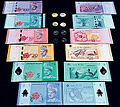Malaysian ringgit facts for kids
Quick facts for kids Malaysian ringgit |
|||
|---|---|---|---|
| Ringgit Malaysia (Malay) ريڠݢيت مليسيا (Jawi) |
|||
|
|||
| ISO 4217 Code | MYR | ||
| Official user(s) | |||
| Unofficial user(s) |
List
Southeast Asia:
∟ ∟ ∟ ∟ ∟ East Asia: ∟ |
||
| Inflation | 3.38% (2022) | ||
| Source | Department of Statistics, Malaysia | ||
| Subunit | |||
| 1⁄100 | sen | ||
| Symbol | RM | ||
| sen | kupang (1⁄10 subunit, notably in Kedah and northern Peninsular Malaysia) | ||
| Plural | The language(s) of this currency does not have a morphological plural distinction. | ||
| Coins | |||
| Freq. used | 5, 10, 20, 50 sen | ||
| Rarely used | 1 sen (discontinued, still legal tender) | ||
| Banknotes | |||
| Freq. used | RM1, RM5, RM10, RM20, RM50, RM100 | ||
| Rarely used | RM2 (discontinued, still legal tender); RM60, RM600 (commemorative) | ||
The Malaysian ringgit is the official money of Malaysia. It is also known as Ringgit Malaysia in the Malay language. The currency uses the symbol RM and the code MYR. The Central Bank of Malaysia issues the ringgit. Each ringgit is divided into 100 smaller units called sen.
Contents
What Does 'Ringgit' Mean?
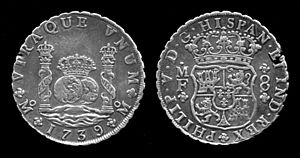
The word ringgit comes from an old Malay word. It means "jagged" or "serrated". This name was first used for the Spanish coins that were common in the region. These coins had rough, jagged edges.
The Spanish controlled the nearby Philippines. This is why their coins were widely used in Malaysia. An old dictionary from 1812 already called the ringgit a unit of money.
Today, ringgit almost always means the Malaysian currency. The money of Singapore and Brunei are also called ringgit in Malay. But to avoid confusion, Malaysia's money is called Ringgit Malaysia. That is why its official symbol is RM.
In some parts of Malaysia, especially in the north, a 10 sen coin is called kupang. Tamil-speaking people in Malaysia call ringgit veḷḷi, which means "silver". They use kācu for sen, which is where the English word "cash" comes from.
A Brief History of Malaysian Money
Early Money Before Independence
Before Malaysia became independent, the Spanish dollar was very important. It was used for trade across Asia and the Americas. This Spanish dollar was eventually called the ringgit.
Later, other dollars appeared in the region. These included the Straits dollar, Sarawak dollar, and British North Borneo dollar. These currencies eventually led to the Malayan dollar and the Malaya and British Borneo dollar. Finally, these became the modern Malaysian ringgit, Singapore dollar, and Brunei dollar.
The Ringgit After Independence (1967-1997)
On June 12, 1967, the Malaysian dollar was introduced. It replaced the Malaya and British Borneo dollar. The new currency kept similar designs and colours. Over the years, small changes were made to the notes and coins.
At first, the Malaysian dollar was linked to the British pound. But this link ended in 1972. The Malaysian dollar then became linked to the U.S. dollar.
For a while, Malaysian, Singaporean, and Brunei dollars could be exchanged for each other at the same value. This agreement ended on May 8, 1973. However, Singapore and Brunei still keep their currencies interchangeable.
In 1975, the names ringgit and sen became the only official names. Before that, they were also called dollars and cents in English. In 1993, the symbol "RM" was introduced. It replaced the old dollar sign "$".
The Ringgit During the Asian Financial Crisis (1997-2005)
Between 1995 and 1997, the ringgit's value changed freely against the US dollar. But in 1997, the 1997 Asian financial crisis hit. Many people took their money out of Malaysia. This caused the ringgit's value to drop a lot.
In September 1998, the Central Bank of Malaysia decided to fix the ringgit's value. It was set at 3.80 ringgit for every US dollar. This helped to stabilize the economy. Also, the ringgit could no longer be traded outside Malaysia. This stopped more money from leaving the country.
Because of the crisis, the RM500 and RM1,000 banknotes were stopped. These large notes were used to move a lot of money out of the country. From July 1, 1999, these notes were no longer valid. You could only exchange them at the central bank.
On July 21, 2005, Malaysia stopped linking the ringgit to the US dollar. Now, the ringgit's value can change more freely. The central bank still watches the market to keep the ringgit stable.
Recent Performance of the Ringgit (2005-Present)
After the peg ended, the ringgit's value went up against the US dollar. It reached 3.16 ringgit per US dollar in April 2008. There were talks about allowing the ringgit to be traded outside Malaysia again. But the government decided to keep it non-tradeable. This helps prevent currency speculation.
Later, the ringgit's value dropped again. This was due to political changes and falling oil prices. It also dropped because of the 1Malaysia Development Berhad scandal. This scandal involved claims of money being moved out of the country. The ringgit reached its lowest point since 1998 in September 2015.
In November 2016, the Central Bank of Malaysia took action. They cracked down on illegal trading of the ringgit. Since then, the ringgit has slowly gained value against the US dollar. Its value also improved against other major currencies.
Coins of Malaysia
First Series Coins (1967)
The first Malaysian coins were introduced in 1967. They came in 1, 5, 10, 20, and 50 sen values. A 1 ringgit coin was added in 1971. These coins had similar designs. They showed the Malaysian Houses of Parliament and the federal star and crescent moon.
The 1 sen coin was made of bronze, then copper-clad steel. Other coins were made of cupronickel. The 50 sen coin was changed in 1971 to have "Bank Negara Malaysia" written on its edge. These coins were designed by Geoffrey Colley.
The 1 ringgit coin was not very popular. People preferred the 1 ringgit banknote. These first series coins are still legal tender but are rarely seen today.
| First series | |||||||||
|---|---|---|---|---|---|---|---|---|---|
| Image | Value | Technical parameters | Description | Date of | |||||
| Obverse | Reverse | Diameter | Composition | Edge | Reverse | Obverse | First minting | Issue | |
| 1 sen | 18 mm | Bronze | Plain | Parliament House and a 14-pointed star and crescent moon | State title, value, year of minting | 1967 | 12 June 1967 | ||
| 1 sen | Copper-clad steel | 1973 | 1973 | ||||||
| 5 sen | 16 mm | Cupronickel | Reeded | Parliament House and a 14-pointed star and crescent moon | State title, value, year of minting | 1967 | 12 June 1967 | ||
| 10 sen | 19 mm | ||||||||
| 20 sen | 23 mm | ||||||||
| 50 sen | 28 mm | ||||||||
| 50 sen | Lettered "Bank Negara Malaysia" in block caps | 1971 | 1 May 1971 | ||||||
| $1 | 33 mm | Lettered "Bank Negara Malaysia" in block caps | Parliament House and a 14-pointed star and crescent moon. The crescent and stars are depicted in thinner forms; the crescent itself is significantly larger and situated in the same position as the Parliament House. | 1971 | 1 May 1971 | ||||
Second Series Coins (1989)
The second series of coins came out in 1989. They had new designs but kept similar sizes. These coins showed elements of Malay culture. For example, the 10 sen coin had a congkak board. The 50 sen coin featured a wau bulan (moon kite). The national flower, the Bunga Raya (hibiscus), was also included. Low Yee Kheng designed this series.
The 1 ringgit coin was made smaller. It was also made from a different metal mix. In 1993, the "$1" symbol on the coin was changed to "RINGGIT". This 1 ringgit coin was removed from circulation in 2005. This was because there were problems with different versions and fake coins.
Since 2008, prices are rounded to the nearest 5 sen when you pay. This means the 1 sen coin is not used as much. However, 1 sen coins are still legal for payments up to RM2.00.
| Second series | ||||||||||
|---|---|---|---|---|---|---|---|---|---|---|
| Image | Value | Technical parameters | Description | Date of | ||||||
| Obverse | Reverse | Diameter | Mass | Composition | Edge | Reverse | Obverse | First minting | Issue | |
| 1 sen | 18 mm | 1.74 g | Bronze-clad steel | Plain | Rebana ubi | Bank title, value, year of minting | 1989 | 4 September 1989 | ||
| 5 sen | 16 mm | 1.41 g | Cupronickel | Reeded | Gasing | Bank title, value, year of minting | 1989 | 4 September 1989 | ||
| 10 sen | 19 mm | 2.82 g | Congkak | |||||||
| 20 sen | 23 mm | 5.66 g | Betel & areca chew container | |||||||
| 50 sen | 28 mm | 9.33 g | Lettered "Bank Negara Malaysia" | Wau | ||||||
| $1 | 24 mm | 9.30 g | Copper-zinc-tin | Reeded | Keris and scabbard with a songket background | Bank title, "$1", year of minting | 1989 | 4 September 1989 | ||
| RM1 | Bank title, "1 RINGGIT", year of minting | 1993 | Unknown | |||||||
| For table standards, see the coin specification table. | ||||||||||
Third Series Coins (2012)
The third series of coins was released on January 16, 2012. Their theme is "Distinctively Malaysia". The designs show plants and animals from different Malaysian cultures. This reflects Malaysia's diverse identity. The coins are 5, 10, 20, and 50 sen.
These new coins are cheaper to make. The 20 sen and 50 sen coins changed from silver to yellow. The front of the coins has new designs. They feature fourteen dots for the states and federal territories. Five horizontal lines represent the five principles of Rukunegara.
The 50-cent coin has nine indentations. It also has a special security feature. When you tilt the coin, you can see "50" and "SEN".
| Third series | ||||||||||
|---|---|---|---|---|---|---|---|---|---|---|
| Image | Value | Technical parameters | Description | Date of | ||||||
| Obverse | Reverse | Diameter | Mass | Composition | Edge | Reverse | Obverse | First minting | Issue | |
| 5 sen | 17.78 mm | 1.72 g | Stainless steel | Plain | 14 dots, five horizontal lines, sulur kacang (pea tendrils) motif, "destar siga" cloth motif of the Kadazan-Dusun tribes |
Bank title, value, year of minting, the national flower | 2011 | 16 January 2012 | ||
| 10 sen | 18.80 mm | 2.98 g | Milled | 14 dots, five horizontal lines, Weave pattern of the Mah Meri people. |
||||||
| 20 sen | 20.60 mm | 4.18 g | Nickel-brass | Milled | 14 dots, five horizontal lines, bunga melur (Jasmine flower) motif on the foreground with a "destar siga" motif on the background | |||||
| 50 sen | 22.65 mm | 5.66 g | Nickel-brass clad copper | Coarse | 14 dots, sulur kacang (pea tendrils) motif and fine lines denoting security feature |
|||||
| For table standards, see the coin specification table. | ||||||||||
Kijang Emas Gold Coins
Malaysia also has special gold coins called "Kijang Emas". A kijang is a type of deer, and it's part of the Central Bank of Malaysia's logo. These coins come in RM50, RM100, and RM200 values. They are made of pure gold.
The Kijang Emas coins are mostly for investment. They are not used for daily shopping. Their price changes with the international gold market. Malaysia became the twelfth country to issue its own gold bullion coins in 2001.
Banknotes of Malaysia
First Series Banknotes (1967)
The Central Bank of Malaysia first issued banknotes on June 6, 1967. They were in $1, $5, $10, $50, and $100 values. A $1000 note was added in 1968. These first banknotes showed Tuanku Abdul Rahman. He was the first King (Yang di-Pertuan Agong) of independent Malaya.
In 1972, the banknotes started using the new official Malay spelling. Both old and new spelling notes were used together.
| First series | ||||||||
|---|---|---|---|---|---|---|---|---|
| Image | Value | Main colour | Description | Date of issue | Issue suspended | Date of withdrawal | ||
| Obverse | Reverse | Obverse | Reverse | |||||
 |
$1 | Blue | Tuanku Abdul Rahman (1895–1960) | Central Bank of Malaysia Logo, the Kijang Emas | June 1967 | 1984 | Limited | |
 |
$5 | Green | ||||||
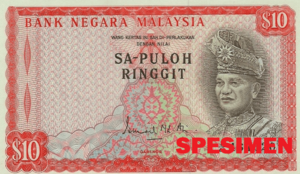 |
$10 | Red | 1983 | |||||
 |
$50 | Blue/grey | ||||||
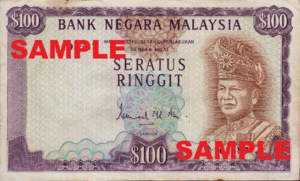 |
$100 | Violet | ||||||
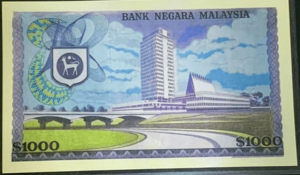 |
$1000 | purple/green | Parliament building in Kuala Lumpur | 2 September 1968 | 1984 | 1999 | ||
| For table standards, see the banknote specification table. | ||||||||
Second Series Banknotes (1982-1984)
The second series of banknotes came out between 1982 and 1984. Their main theme was traditional Malaysian designs. New $20 and $500 notes were introduced. The $10, $50, and $100 notes were redesigned. Finally, the $1, $5, and $1000 notes were updated.
In 1986, a security strip was added to most notes. The $1 notes stopped being printed in 1993. The $1 coin replaced them. The $20 notes were not popular and were removed from circulation by 1995.
In 1999, the RM500 and RM1000 notes were stopped. They were no longer legal tender. This was done to control money leaving the country during the Asian financial crisis.
| Second series | |||||||||
|---|---|---|---|---|---|---|---|---|---|
| Image | Value | Main colour | Description | Date of issue | Issue suspended | Date of withdrawal | Remark | ||
| Obverse | Reverse | Obverse | Reverse | ||||||
 |
$1 | Blue | Tuanku Abdul Rahman | The National Monument in Kuala Lumpur | 1984 | 1993 | Limited | with blind mark before 1986; none since 1986. | |
 |
 |
$5 | Green | Then current Istana Negara in Kuala Lumpur | 1984 | 1999 | |||
| $10 | Red | Kuala Lumpur Railway Station | 1983 | 1998 | |||||
| $20 | Brown/white | Central Bank of Malaysia headquarters in Kuala Lumpur | 1982 | 1995 | |||||
| $50 | Blue/grey | National Museum in Kuala Lumpur | 1983 | 1998 | |||||
| $100 | Violet | National Mosque in Kuala Lumpur | 1983 | ||||||
| $500 | Orange | Then current Supreme Court building in Kuala Lumpur | 1982 | 1999 | |||||
| $1000 | Blue/green | Parliament building in Kuala Lumpur | 1984 | 1999 | |||||
| For table standards, see the banknote specification table. | |||||||||
Third Series Banknotes (1996)
The third series of banknotes was issued in 1996. Their designs were inspired by Malaysia's vision for the future, called Wawasan 2020. This series included RM1, RM2, RM5, RM10, RM50, and RM100 notes. The RM50 and RM100 notes had a special hologram strip. This was to prevent people from making fake money.
In 2004, a new RM10 note was released with more security features. A new RM5 note was also issued. This RM5 note was made of plastic (polymer) and had a clear window. The central bank planned to replace all paper notes with polymer ones.
| Third series | ||||||||||
|---|---|---|---|---|---|---|---|---|---|---|
| Image | Value | Dimensions | Main colour | Description | Date of issue | Issue suspended | Date of withdrawal | Remark | ||
| Obverse | Reverse | Obverse | Reverse | |||||||
| RM1 | 120 × 65 mm | Blue | Tuanku Abdul Rahman | Mount Kinabalu, Mount Mulu and "Wau Bulan" kite | 8 November 2000 | 16 July 2012 | Limited | Paper | ||
| RM2 | 130 × 65 mm | Lilac | Menara Kuala Lumpur communications tower and the MEASAT satellite | 5 February 1996 | 1 January 2000 | Paper | ||||
| RM5 | 135 × 65 mm | Green | Multimedia Super Corridor, KLIA and Petronas Twin Towers | 27 September 1999 | 26 October 2004 | Paper | ||||
| 26 October 2004 | 16 July 2012 | Polymer (Biaxially-oriented polypropylene) | ||||||||
| RM10 | 140 × 65 mm | Red | Putra LRT train, Malaysia Airlines Boeing 777 aircraft and MISC ship | 10 January 1998 | 5 January 2004 | Paper (without holographic strip) | ||||
| 5 January 2004 | 16 July 2012 | Paper (with holographic strip) | ||||||||
| RM50 | 145 × 69 mm | Blue/grey | Mining, Petronas oil platform | 20 July 1998 | 30 January 2008 | Paper (with holographic strip) | ||||
| RM100 | 150 × 69 mm | Violet | Proton car production line and engine | 26 October 1998 | 16 July 2012 | Paper (with holographic strip) | ||||
| For table standards, see the banknote specification table. | ||||||||||
Fourth Series Banknotes (2012)
In 2008, a new RM50 banknote was released. Its theme was "National Mission". This showed Malaysia's goal to improve its economy. The note kept the portrait of Tuanku Abdul Rahman. It also featured the national flower, the hibiscus. Designs from songket weaving were included.
The first 50 million new RM50 notes had a special design. They showed Tunku Abdul Rahman, Malaysia's first Prime Minister. They also had the logo for the 50th Anniversary of Independence. These notes had many security features to prevent fakes.
In 2011, the Central Bank announced a new series of banknotes. This series brought back the RM20 note. The designs were revealed in December 2011. They started circulating on July 16, 2012. All notes in this series keep the portrait of Tuanku Abdul Rahman.
| Fourth series | |||||||||
|---|---|---|---|---|---|---|---|---|---|
| Image | Value | Dimensions | Main colour | Substrate | Description | Date of issue | Remark | ||
| Obverse | Reverse | Obverse | Reverse | ||||||
| RM1 | 120 × 65 mm | Blue | Polymer | Tuanku Abdul Rahman with the national flower, hibiscus, and patterns of the traditional fabric – the songket | Wau bulan | 16 July 2012 | |||
| RM5 | 135 × 65 mm | Green | Rhinoceros hornbill | 16 July 2012 | |||||
| RM10 | 140 × 65 mm | Red | Paper | Rafflesia | 16 July 2012 | ||||
| RM20 | 145 × 65 mm | Orange | Hawksbill and leatherback turtle | 16 July 2012 | |||||
| RM50 | 145 × 69 mm | Blue and green | Malaysia's first Prime Minister, Tunku Abdul Rahman Putra Al-Haj, Oil palm trees with the 50th Anniversary logo. | 30 January 2008 | Circulating notes (Prefix from AA0020001 to AE) | ||||
| Cyan | Malaysia's first Prime Minister, Tunku Abdul Rahman Putra Al-Haj, Oil palm trees without the 50th Anniversary logo. | 15 July 2009 | Circulating notes (Starting prefix AF) | ||||||
| 16 July 2012 | Circulating notes (Prefix AAA) | ||||||||
| RM100 | 150 × 69 mm | Purple | Mount Kinabalu and pinnacles rock formations of Gunung Api valley | ||||||
| These images are to scale at 0.7 pixel per millimetre. For table standards, see the banknote specification table. | |||||||||
Special Commemorative Banknotes
1998 Commonwealth Games Note
A special RM50 polymer banknote was issued on June 1, 1998. This was to celebrate the 1998 Commonwealth Games held in Kuala Lumpur. It was the first polymer banknote from Malaysia. These notes were mainly for collectors and are rarely used in daily life.
50th Anniversary of Independence Note
On December 21, 2007, a commemorative RM50 banknote was released. It marked Malaysia's 50th year of independence. This note looked like the regular RM50 note. But it had an extra logo for the 50th Anniversary and the date "1957-2007".
60th Anniversary of Independence Agreement Note
On December 14, 2017, two more special banknotes were issued. They celebrated 60 years since the signing of the Federation of Malaya Independence Agreement. These were RM60 and RM600 notes. The RM600 note is the largest legal banknote ever issued in the world! It measures 370mm by 220mm.
These notes were sold at a higher price because they are collector's items.
| Commemorative | ||||||||
|---|---|---|---|---|---|---|---|---|
| Image | Value | Dimensions | Main colour | Description | Date of issue | Remark | ||
| Obverse | Reverse | Obverse | Reverse | |||||
| [1] | [2] | RM50 | 152 × 76 mm | Yellow and green | Tuanku Abdul Rahman, the skyline of Kuala Lumpur (with the Petronas Twin Towers) | Bukit Jalil Sports complex | 1 June 1998 | Polymer (Biaxially-oriented polypropylene) |
| [3] | [4] | RM50 | 145 × 69 mm | Blue and green | Tuanku Abdul Rahman with the national flower, hibiscus | Malaysia's first Prime Minister, Tunku Abdul Rahman Putra Al-Haj and the logo of the 50th Anniversary of Independence. Oil palm trees | 26 December 2007 | First 20,000 identified with yellow border at both sides (Prefix from AA 0000001 to AA 0020000). |
| [5] | [6] | RM60 | 162 × 84 mm | Yellow and green | Royal throne encircled by the portraits of 15 Yang di-Pertuan Agong | Portraits of the nine rulers signing the Federation of Malaya Independence Agreement, silhouette of Tunku Abdul Rahman Putra Al-Haj, National Palace, Perdana Putra, Parliament building and Palace of Justice | 14 December 2017 | Polymer and paper substrate |
| [7] | [8] | RM600 | 370 × 220 mm | Yellow and green | Royal throne encircled by the portraits of 15 Yang di-Pertuan Agong | Portraits of the nine rulers signing the Federation of Malaya Independence Agreement, silhouette of Tunku Abdul Rahman Putra Al-Haj, National Palace, Perdana Putra, Parliament building and Palace of Justice | 14 December 2017 | Polymer and paper substrate |
| These images are to scale at 0.7 pixel per millimetre. For table standards, see the banknote specification table. | ||||||||
Images for kids





